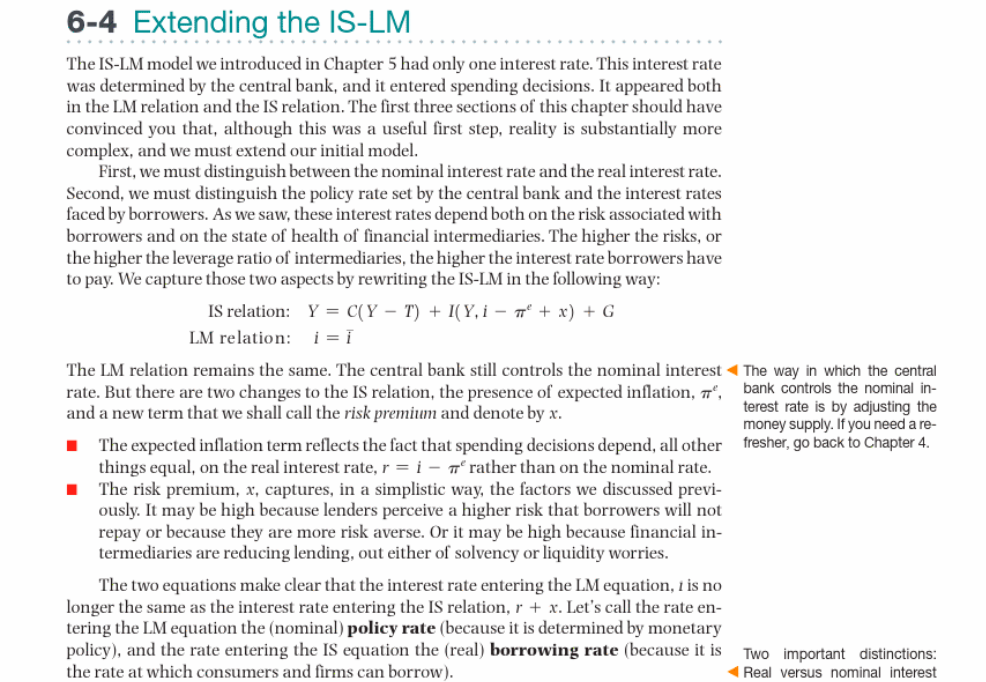
6-4 Extending the IS-LM The IS-LM model we introduced in Chapter 5 had only one interest rate. This interest rate was determined by the central bank, and it entered spending decisions. It appeared both in the LM relation and the IS relation. The first three sections of this chapter should have convinced you that, although this was a useful first step, reality is substantially more complex, and we must extend our initial model. First, we must distinguish between the nominal interest rate and the real interest rate. Second, we must distinguish the policy rate set by the central bank and the interest rates faced by borrowers. As we saw, these interest rates depend both on the risk associated with borrowers and on the state of health of financial intermediaries. The higher the risks, or the higher the leverage ratio of intermediaries, the higher the interest rate borrowers have to pay. We capture those two aspects by rewriting the IS-LM in the following way: IS relation: Y = C(Y - T) + I(Yi - 7" + x) + G LM relation: i = 1 The LM relation remains the same. The central bank still controls the nominal interest The way in which the central rate. But there are two changes to the IS relation, the presence of expected inflation, 7, bank controls the nominal in- and a new term that we shall call the risk premium and denote by x. terest rate is by adjusting the money supply. If you need a re- | The expected inflation term reflects the fact that spending decisions depend, all other fresher, go back to Chapter 4. things equal, on the real interest rate, r = i - a rather than on the nominal rate. The risk premium, x, captures, in a simplistic way, the factors we discussed previ- ously. It may be high because lenders perceive a higher risk that borrowers will not repay or because they are more risk averse. Or it may be high because financial in- termediaries are reducing lending, out either of solvency or liquidity worries. The two equations make clear that the interest rate entering the LM equation, 1 is no longer the same as the interest rate entering the IS relation, r + x. Let's call the rate en- tering the LM equation the (nominal) policy rate (because it is determined by monetary policy), and the rate entering the IS equation the (real) borrowing rate (because it is Two important distinctions: the rate at which consumers and firms can borrow). Real versus nominal interest 6-4 Extending the IS-LM The IS-LM model we introduced in Chapter 5 had only one interest rate. This interest rate was determined by the central bank, and it entered spending decisions. It appeared both in the LM relation and the IS relation. The first three sections of this chapter should have convinced you that, although this was a useful first step, reality is substantially more complex, and we must extend our initial model. First, we must distinguish between the nominal interest rate and the real interest rate. Second, we must distinguish the policy rate set by the central bank and the interest rates faced by borrowers. As we saw, these interest rates depend both on the risk associated with borrowers and on the state of health of financial intermediaries. The higher the risks, or the higher the leverage ratio of intermediaries, the higher the interest rate borrowers have to pay. We capture those two aspects by rewriting the IS-LM in the following way: IS relation: Y = C(Y - T) + I(Yi - 7" + x) + G LM relation: i = 1 The LM relation remains the same. The central bank still controls the nominal interest The way in which the central rate. But there are two changes to the IS relation, the presence of expected inflation, 7, bank controls the nominal in- and a new term that we shall call the risk premium and denote by x. terest rate is by adjusting the money supply. If you need a re- | The expected inflation term reflects the fact that spending decisions depend, all other fresher, go back to Chapter 4. things equal, on the real interest rate, r = i - a rather than on the nominal rate. The risk premium, x, captures, in a simplistic way, the factors we discussed previ- ously. It may be high because lenders perceive a higher risk that borrowers will not repay or because they are more risk averse. Or it may be high because financial in- termediaries are reducing lending, out either of solvency or liquidity worries. The two equations make clear that the interest rate entering the LM equation, 1 is no longer the same as the interest rate entering the IS relation, r + x. Let's call the rate en- tering the LM equation the (nominal) policy rate (because it is determined by monetary policy), and the rate entering the IS equation the (real) borrowing rate (because it is Two important distinctions: the rate at which consumers and firms can borrow). Real versus nominal interest







